New York-style Pizza
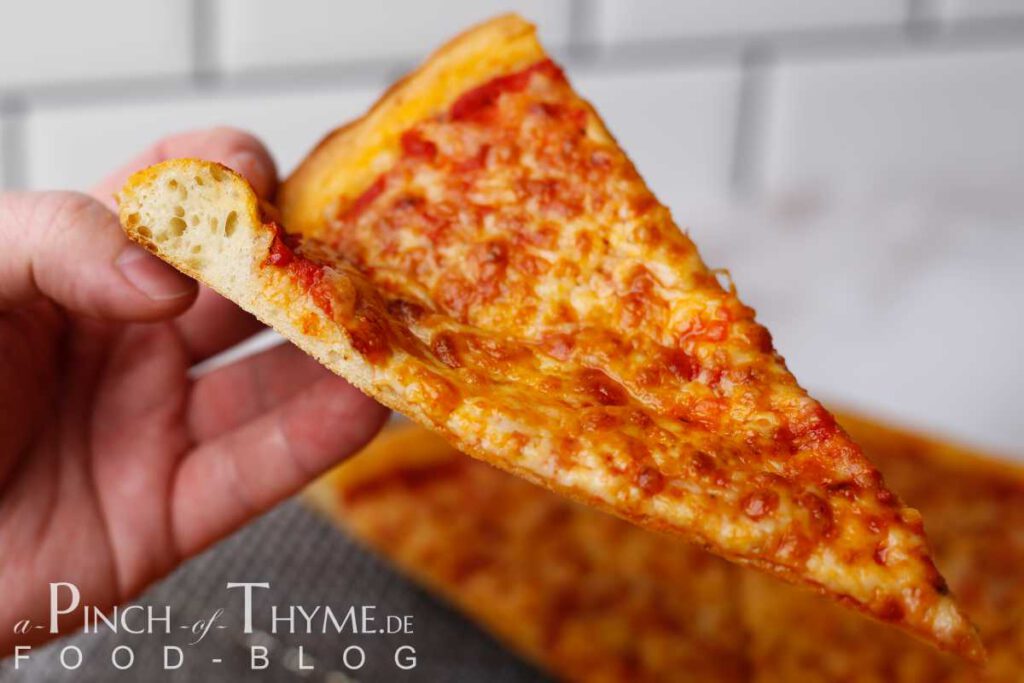
New York-style pizza is more than just a meal; it’s a symbol for the city that never sleeps, and an essential part of New York’s dining culture. It was first introduced by Italian immigrants and has since evolved into a unique style of pizza that is known and loved worldwide.
My Fascination for New York-style Pizza
My encounter with this unique style of pizza began digitally, several years ago, far removed from the bustling streets of New York. Through social media, particularly through Reddit, the Pizza Making Forum, and YouTube (“One bite, everybody knows the rules!”), I was introduced to the world of New York pizza. Every post, every video showcasing the thin, crispy crust, the abundantly melted cheese, and the perfect balance of flavors only drew me deeper into this world of New York-style pizza.
This digital encounter sparked a true passion within me. I spent hours studying tutorials, comparing recipes, exchanging with other pizza fanatics, and learning the tricks of the trade, all in an effort to replicate the perfect New York-style pizza in my own kitchen.
Although I have not yet tasted the real New York-style pizza, fresh from the oven of a New York pizzeria, I feel a strong connection to this pizza through my own culinary adventures and my immersion into the online community of pizza lovers. I would now like to share this personal journey and the insights I have gained along the way with you. I invite you to join me in unveiling the mystery of New York-style pizza, discovering its history, understanding its significance in New York culture, and of course, learning how to prepare it yourself at home. This way, you too can bring a slice of New York into your kitchen, wherever you may be.
The Birth of New York-style Pizza
The history of New York-style pizza is closely intertwined with the history of immigration to the United States. In the second half of the 19th century, a large wave of Italian immigrants reached American shores, many of them coming from Naples, the birthplace of pizza.
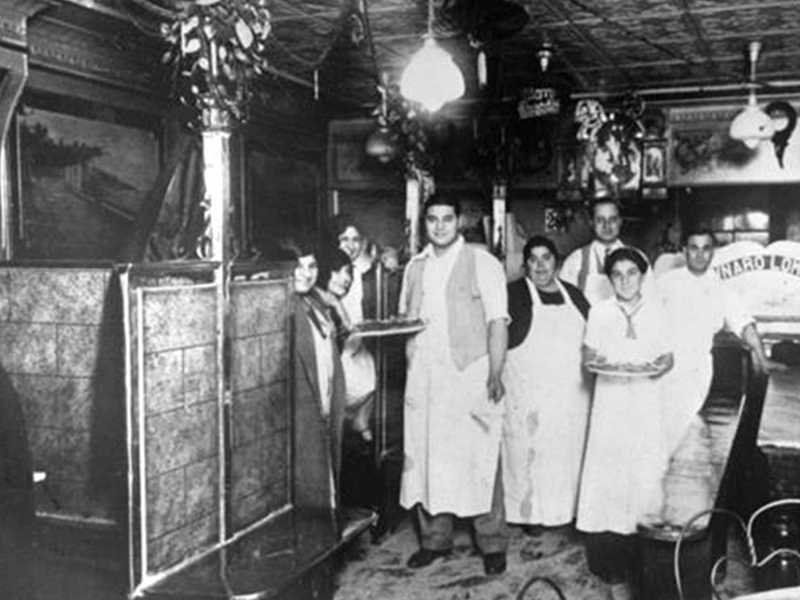
One of these immigrants was Gennaro Lombardi, who opened the first known pizzeria in the United States in Manhattan in 1905. Lombardi’s pizzas were heavily influenced by the Neapolitan tradition, but they also adapted to local ingredients and tastes.
Over time, New York pizza began to differentiate itself from its Neapolitan roots. The crust became thinner and crispier, the pizza overall larger, and it was served in slices rather than as a whole. These adjustments made the pizza a practical street food for busy New Yorkers who wanted to eat their pizza “on the go”.
New York-style pizza quickly became popular and spread throughout the United States in the following decades and eventually internationally. Today, it is an indispensable part of New York’s culinary heritage and one of the most popular pizza varieties worldwide.
Characteristic Features of New York-style Pizza
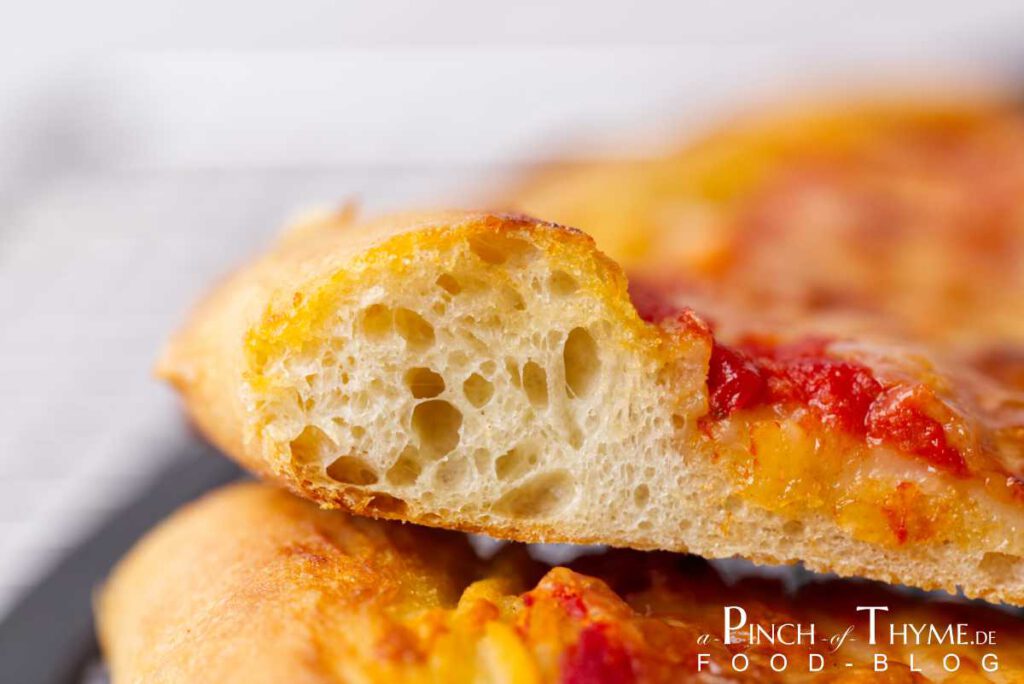
Appearance: Size, Shape, Topping
New York-style pizza is known for its considerable size and thin yet robust crust. It typically has a diameter of 45-60 cm and is cut into wide, triangular slices. This allows the pizza to be folded and eaten on the go, a practice widely adopted in New York.
The edges of the pizza are slightly thicker to hold the toppings, while the rest remains thin and crispy. The topping of a classic New York-style pizza consists of a simple but flavorful tomato sauce and a generous layer of firm mozzarella cheese. It’s not uncommon for the pizza to be topped with additional ingredients such as sausage, pepperoni (in the US, “pepperoni” refers to a type of spicy salami), mushrooms, or green bell peppers, but the traditional New York pizza is best in its simplicity.
Taste: Seasoning, Texture, Blend of Ingredients
The pizza stands out for its harmonious blend of flavors and textures. The tomato sauce is slightly sweet, a bit tangy, and subtly spiced, often just with salt, pepper, and oregano. The mozzarella complements the sauce with its rich and creamy taste, creating a delicious harmony between sweet and salty.
The crust and edge offer a satisfying crunch with every bite and perfectly balance the rich toppings. The crumb should have a light, airy texture. This is achieved by typically baking the pizza at very high temperatures, which a standard household oven often can’t reach. Traditional New York pizzerias bake their pizzas in ovens that reach temperatures of 260-370 degrees Celsius.
Requirements for the Flour
An often overlooked but crucial aspect of making an authentic New York-style pizza is choosing the right flour. Traditionally, strong, high-protein flour, often referred to as “bread flour”, is used for the pizza dough. The higher protein content of this flour, around 12.8%, allows for the development of more gluten, which helps to create the characteristic crispy yet elastic texture of the pizza dough.
Some pizza makers swear by special pizza flour brands such as “Americana Tip 00” from the Caputo mill in Italy, which has an even finer grind and a higher protein content (14.25%). Or All Trumps, also around 14.2%. However, these types of flour can be hard to find and are often more expensive than the common flour from the supermarket. Regardless of the type of flour chosen, it is important to knead the dough sufficiently (or stretch and fold) and give it enough time to rest, allowing the gluten to fully develop and thus create a perfect pizza.
A good alternative for German pizza bakers is Type 550 strong bread flour. This flour has a protein content of 12.8% and is therefore similar to the American King Arthur Bread Flour, which is also often used by American amateur pizza bakers. Such flour can be obtained, for example, as a house brand from EDEKA.
Significance in New York Culture
How New York-style Pizza Has Shaped Food in the City
It’s more than just a meal – it’s an essential part of New York’s identity and culture. It reflects the city’s diversity and inventiveness, as it originated from an adaptation of Neapolitan pizza to local preferences and ingredients. Today, it’s an indispensable culinary component of New York.
This pizza has also shaped the way New Yorkers eat. Its practical size and shape have made it the ideal street food, eaten “on the go” – a reflection of the city’s fast and busy lifestyle, similar to the doner kebab in Germany.
Pizzerias and Their Significance in the Local Community
Pizzerias play an important role in New York’s communities. They often serve as meeting places for neighbors, places where friendships are formed and memories are made. Some pizzerias, like Lombardi’s, Totonno’s, and Di Fara’s, have been in operation for generations and have evolved into local institutions.
However, New York’s pizza culture goes beyond the city limits. It has a global fan base and has inspired many other pizza styles. Despite this global spread, New York-style pizza remains primarily a product of New York – a proud symbol of the city and its residents.
New York-style pizza is not just a culinary delight, but also a window into the culture and community of New York. It is proof of how food can shape a city, connect communities, and tell stories.
Resume
New York-style pizza is more than just a meal – it’s a cultural phenomenon that has been nurtured and evolved over generations. It’s a reflection of the diversity and dynamic character of New York City and represents the passion and artisanal skill of the pizza makers who keep this tradition alive.
Although I’ve never had the opportunity to taste a real New York-style pizza, exploring its history, its distinctive features, and the role it plays in New York’s culture has only made me more curious. It’s a wonderful example of how food can help bring communities together and create memories.
I hope this article has piqued your curiosity about this pizza, and maybe even sparked a desire to try it for yourself – whether in one of the legendary pizzerias in New York, or by preheating the oven and conjuring up the magic of New York pizza in your own home with my recipe. Because that’s the true beauty of cuisine: it invites us to discover new tastes, learn new skills, and above all, enjoy the moment.
Either way, one thing is certain: New York-style pizza will continue to be a staple of New York’s culinary landscape and inspire pizza lovers all over the world.
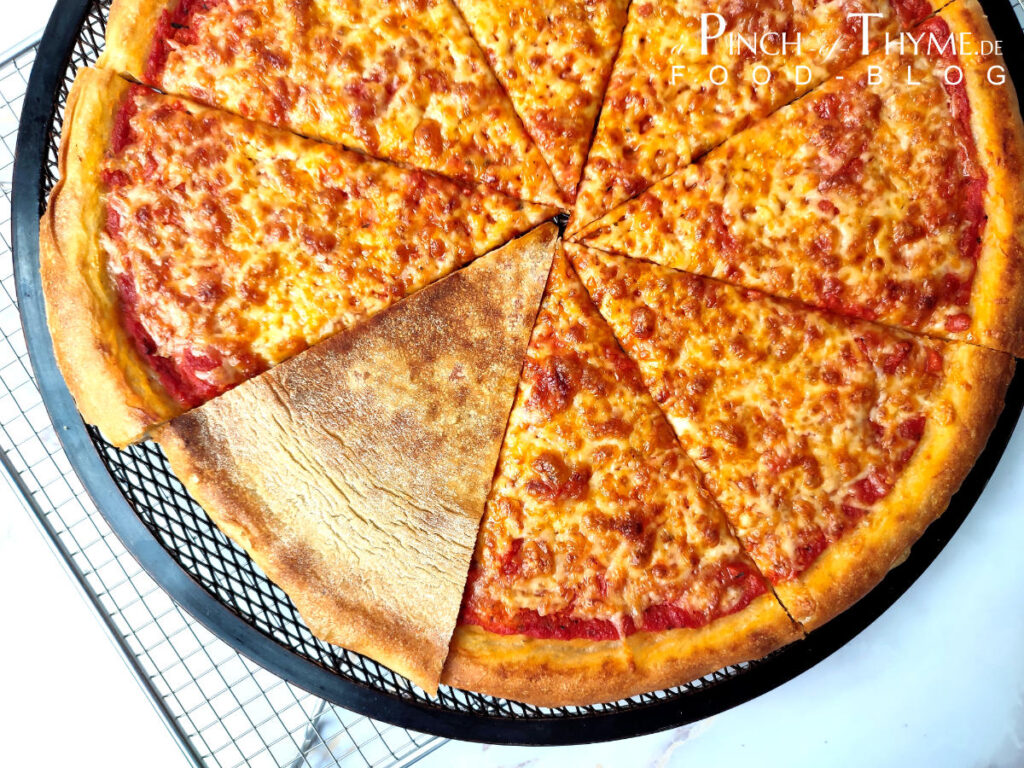
Rezept: New York-style Pizza
Dough Composition
| INGREDIENTS | WEIGHT (G) | BAKER'S-% | TRUE-% |
|---|---|---|---|
| Bread Flour (12.8%) | 295 | 100 | 58,35 |
| Water | 186 | 63,05 | 36,79 |
| Salt | 8,85 | 3 | 1,75 |
| Oil | 9 | 3,05 | 1,78 |
| Sugar | 6 | 2,03 | 1,19 |
| Instant Dry Yeast | 0,75 | 0,25 | 0,15 |
| SUM | 506 | 171 | 100 |
The percentage values (baker’s %) always refer to the amount of flour. This makes it easier to make changes and you can see the composition of the dough at a glance. The hydration (water content), salt content, etc.
Note on the cheese
Typically, low-moisture mozzarella is used. The grated mozzarella available here in Germany from the supermarket is treated with a separating agent (cornstarch) which is supposed to prevent the cheese from clumping but can also negatively affect the melting behavior.
Therefore, I recommend removing the starch before use to ensure the optimal melting behavior of the mozzarella. To do this, put the grated cheese into a large bowl of water and wash off the cornstarch. Repeat this process about three times, or until the water remains (somewhat) clear. Then put the cheese in a sieve and let it drain for about an hour, preferably in the refrigerator.
Optional Ingredients: Ascorbic Acid and Sodium Bicarbonate
Ascorbic acid in the dough
Ascorbic acid, also known as vitamin C, can be used as a dough improver in bread and pizza dough. It has various positive effects on the dough:
- Improved gluten development: Ascorbic acid aids in the formation of strong gluten structures in the dough. Gluten is the protein in wheat flour that is responsible for the elasticity and strength of the dough. A stronger gluten structure leads to a dough that can better hold gas during fermentation, resulting in a lighter, airier bread or pizza crust.
- Better browning: Ascorbic acid can enhance the Maillard reaction, a chemical process that occurs during baking and is responsible for the golden-brown color and delicious taste of baked bread or pizza.
The addition of ascorbic acid can therefore lead to a better end product, both in terms of texture and taste, as well as the shelf life of the baked bread or pizza. However, it should be noted that too much ascorbic acid can overdevelop the dough and make it tough. Therefore, it should be used in moderation.
Sodium Bicarbonate in the Tomato Sauce
Sodium bicarbonate, also known as baking soda, is an alkaline compound often used in the kitchen to regulate pH levels. In tomato sauce, baking soda can be useful in two main ways:
- Reducing Acidity: Tomatoes are naturally acidic, and sometimes this acidity can be overwhelming in a tomato sauce. A pinch of baking soda can help neutralize the acidity and create a more balanced flavor.
- Flavor Enhancement: Alkaline food, such as tomato sauce treated with baking soda, can lead to flavors being perceived more intensely. This is because alkalines sensitize taste buds, thus enhancing taste perception.
Here, too, it’s important to note that baking soda should be used in moderation, as too much can change the flavor of the sauce and can give it a slightly soapy note.
New York-style Pizza: Foto Documentation

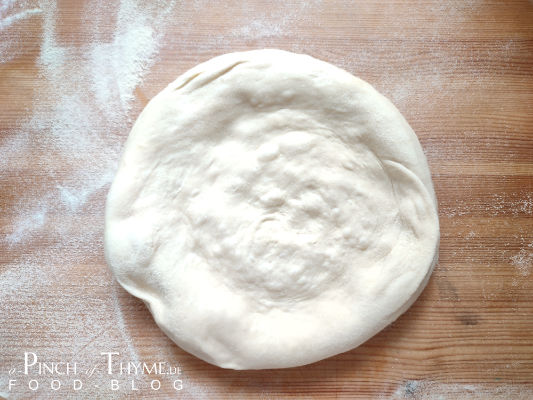
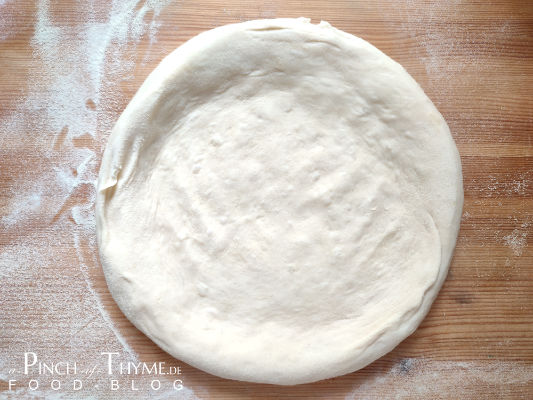

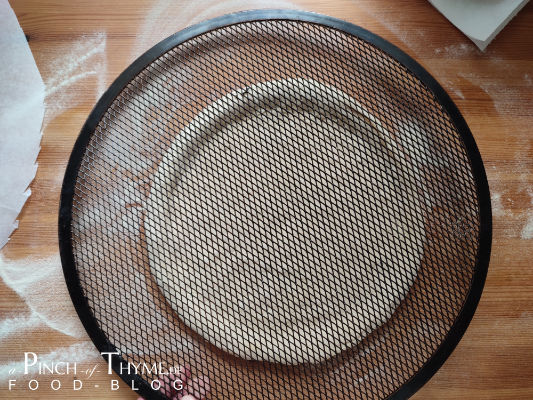
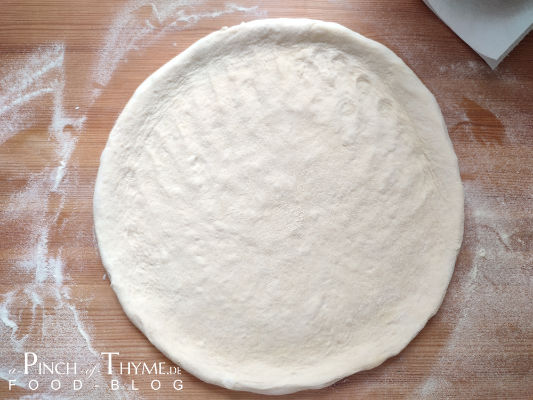

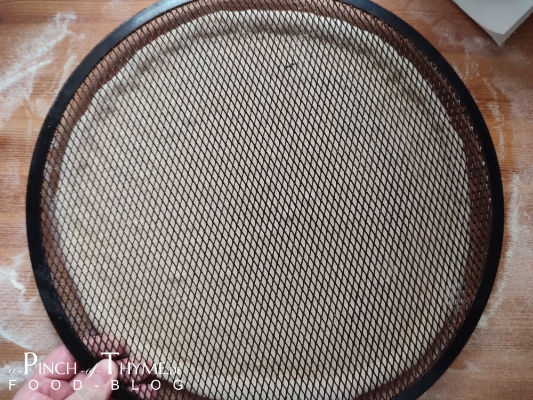
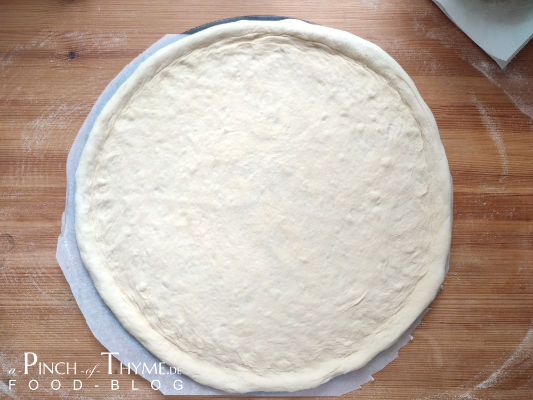
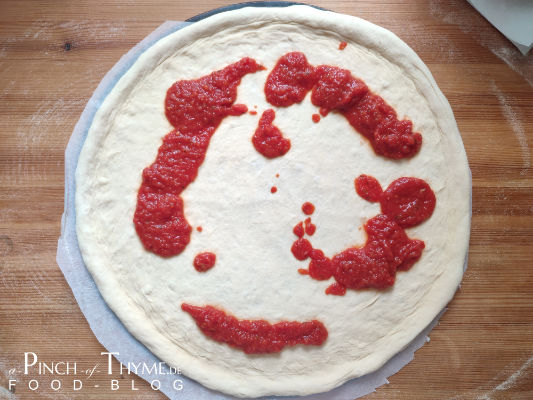
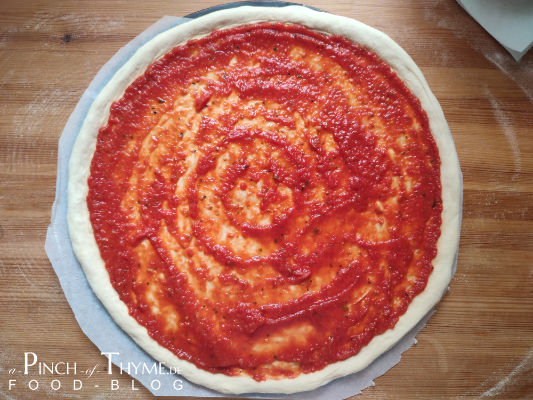
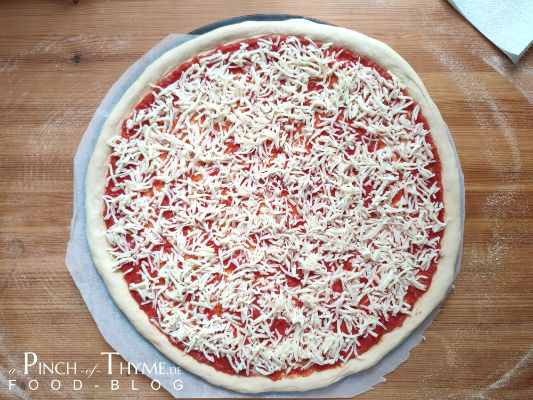
Ingredients and instructions
Dough
- 295 g Bread flour (12.8% protein)
- 186 g Water
- 8,85 g Salt
- 9 g neutral vegetable oil
- 6 g Sugar
- 0,75 Instant Dry Yeast
- 0,1 – 0,15 g Vitamin C (optional)
Sauce
- 200 g canned Tomatoes (e.g. Pelati by Mutti)
- 10 g neutral vegetable oil
- 2 g Sugar
- 0,5 g Salt
- a pinch or two of baking soda (optional)
Toppings
- 250 g grated low-moisture mozzarella
Making the dough:
- Mix 40 ml of the measured water with salt and sugar in a small container, stirring until the solids have largely dissolved.
- In a separate container, dissolve the dry yeast in 10 ml of water.
- Now add the remaining water to the flour and knead everything briefly.
- Let the prepared dough rest for half an hour – this process is called autolysis.
- Now add the yeast-water mixture and the sugar-salt-water solution to the dough and knead everything thoroughly. The dough mass should be homogeneous after about 1-2 minutes.
- Now add the oil and continue kneading until it is completely incorporated into the dough.
- Let the dough rest again for 20 minutes and then perform a stretch and fold process three times at 20-minute intervals.
- Then let the dough rise covered for about 12-18 hours at room temperature.
On the baking day:
- Preheat your oven, along with the pizza stone/baking steel (lower third), for at least an hour at the highest setting (top and bottom heat).
- Bring the tomatoes in a pot together with salt, sugar, oil and thyme/oregano to a boil and let them reduce slightly.
- Put the grated cheese in a large bowl with water and wash off the cornstarch. Repeat this process about three times, or until the water remains (somewhat) clear. Then put the cheese in a sieve and let it drain for about an hour, preferably in the refrigerator.
The Baking:
- Shape the dough, on a surface dusted with durum wheat flour, to the desired final size and place it on a pizza rack. Remove excess durum wheat flour from the edge of the dough with a soft brush.
- Now distribute the tomato sauce with a wide spoon on the dough and sprinkle the previously washed and dried mozzarella on top. Ideally, it should be a little less in the middle.
- Place the pizza screen directly on the floor of the preheated oven and bake the pizza for 6 minutes. During this, you should rotate the pizza 90 degrees every 60-90 seconds.
- Now switch your oven to the grill function.
- Place the pizza rack with the pizza on the pizza stone or baking steel (lower third) and bake for another 4-6 minutes, continuing to rotate the pizza 90 degrees every 60-90 seconds.
- Remove the pizza from the oven and place it on a rack to cool slightly. Brush the edge of the pizza with some oil to highlight the golden color (wet effect).
- Cut the pizza into pieces and enjoy the taste of your homemade New York-style pizza!
Good luck and enjoy your meal!
